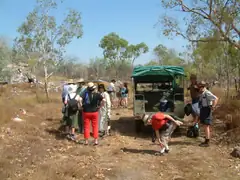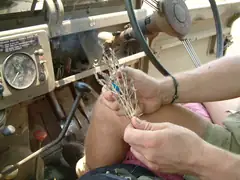 After arriving in Darwin by air I drove to Jabiru where I stayed at the
Gagudju Crocodile Hotel
- I have a weakness for staying in hotels designed like crocodiles.
Heart stopping start to the next day as I couldn’t get
anyone to take me to the airport from the Mobil station, and
when I drove myself Gunbalaya Air services shack was all shut
up! Happily thanks to God unlike me I persevered and met the
pilot Mark. After a not too turbulent flight sitting next
to him I reached the camp at Mount Borradaile.
There isn’t anywhere else similar to this camp I know of that
lets you see Aboriginal rock art without boardwalks or rope
barriers. That lets you be an explorer in the heart of the
wilderness seeing jacanas and their chicks walking on water.
That lets you clamber over rocks to see Aboriginal dwellings and
squeeze through crevices into caves to be mobbed by ghost bats.
That lets you see terrains from the rock country to the rain
forest and learn about the animals and plants and how man
interacted with them.
After arriving in Darwin by air I drove to Jabiru where I stayed at the
Gagudju Crocodile Hotel
- I have a weakness for staying in hotels designed like crocodiles.
Heart stopping start to the next day as I couldn’t get
anyone to take me to the airport from the Mobil station, and
when I drove myself Gunbalaya Air services shack was all shut
up! Happily thanks to God unlike me I persevered and met the
pilot Mark. After a not too turbulent flight sitting next
to him I reached the camp at Mount Borradaile.
There isn’t anywhere else similar to this camp I know of that
lets you see Aboriginal rock art without boardwalks or rope
barriers. That lets you be an explorer in the heart of the
wilderness seeing jacanas and their chicks walking on water.
That lets you clamber over rocks to see Aboriginal dwellings and
squeeze through crevices into caves to be mobbed by ghost bats.
That lets you see terrains from the rock country to the rain
forest and learn about the animals and plants and how man
interacted with them.
I found myself immediately on arrival at Mount Borradaile on a visit to Major Art! Let’s see, termite mounds good for road surfaces, making ovens, eating by native anaemic women. Ironwood bright green tree leaves all parts toxic splinters even. Saw red winged green parrot, English couple man liked birds too, plus terns corollas brolgas kites see eagles et cetera. explicit erotic art, did sunset cruise as well and saw a reticent rock wallaby and an agile wallaby earlier. The ghost bats! White large shapes unsettingly near you. Jared cooking just fine, stench of toilet, cracked clayey earth, saw feral pigs wallowing, hard to see but new English cook spotted him! Resin oozing out of crack in tree, natural decongestants.
 For me the being taken by aged Land Rovers over sand and rock,
having picnics sitting on rock boulders rather than comfy
chairs, having no power in one’s tent when the generator is
turned off, even the pit toilet adds to the feeling you are out
of civilisation, are face to face with the wilderness as much as
is possible for someone like me. You’re fed and looked after
well, and by the end of a few days you almost feel part of the
place. (They’re replacing the pit toilets by the way.)
For me the being taken by aged Land Rovers over sand and rock,
having picnics sitting on rock boulders rather than comfy
chairs, having no power in one’s tent when the generator is
turned off, even the pit toilet adds to the feeling you are out
of civilisation, are face to face with the wilderness as much as
is possible for someone like me. You’re fed and looked after
well, and by the end of a few days you almost feel part of the
place. (They’re replacing the pit toilets by the way.)
Max took just me and a new guide on the billabong cruise then to some burial sites and rock art. Saw a good lot of birds, pelicans sea eagles jacana with chicks, eggs laid in water lily leaves eggs can float pointed at both ends eggs rolled by birds, magpie geese whistling ducks, beautiful. Afternoon Max alone, lightning man and beeswax lady, termite mound interior (arboreal best) use by natives as fuel for mosquito deterrent but lighting fires against mozzies gave them respiratory disorders hence decongestants. Peanut tree flaxseeds.
The guides really know their stuff. Be it spotting Northern Dwarf Reed Frogs as they drive along (2cm of green hiding in green fronds), or noticing the head of a file snake pop out of water (I got to hold one of these non-venomous serpents), or digging up red roots the Aborigines used to colour baskets they’re constantly telling you background lore. If this kind of experience appeals to you then this place is a must.
 The file snake day was a glorious experience. Jared took me and
Kylie and Steve to the flood plain, rare treat as rarely open.
We chased after a
feral pig in the Land Rover, saw Crabs Eye (a bean used by the
Aborigines as an abortifacient to keep the population down).
Saw many brolgas, Grey bird of the plain into flies. Held a file
snake Jared spotted its head peeping out of the river.
Saw loads of art including two dolphins and weird ship.
The Aborigines used Reckitts Blue for colour in
their wall art hand stencils - they adapted. They used
glass china et cetera for cutting edges.
The file snake day was a glorious experience. Jared took me and
Kylie and Steve to the flood plain, rare treat as rarely open.
We chased after a
feral pig in the Land Rover, saw Crabs Eye (a bean used by the
Aborigines as an abortifacient to keep the population down).
Saw many brolgas, Grey bird of the plain into flies. Held a file
snake Jared spotted its head peeping out of the river.
Saw loads of art including two dolphins and weird ship.
The Aborigines used Reckitts Blue for colour in
their wall art hand stencils - they adapted. They used
glass china et cetera for cutting edges.
Jared showed and demonstrated the firecracker plant which on fire literally explodes the seed pods emitting its seeds out. Its life cycle needs fire. On way back from swimming Jared spotted the tiny tiny northern dwarf tree frog. Saw purple swap hens. Back at base camp saw lorikeets. Wallaroo female crossed the road. Got rather smashed at the evening meal, shared wine with Max, noises from Northern land council didn’t help me settle. In fact I went for a leak in the stygian gloom then went and got some water! Strange night.
Kites mobbed the tame goana for ham, Jared dug up red roots which the natives originally beat into the fibres for basket colour. Moluccans gave them iron bowls which they then boiled to dye. Rainbow serpent seen again in company with tour operators planning adventure exercise for Management, both smart and dumb. They wanted to bring chairs rather than sit on rocks, didn’t know heartwood is Deadwood. Kylie asked if sedimentary rocks would melt inside the Earth! I was in sleepy stupor early afternoon so went on a last billabong cruise with Max, tearful farewell then survived the flight back then drove to Aurora resort where I dined on Buffalo crocodile and barramundi. Pit Toilets not so good. Managed to have problems getting into my room at the Aurora! Lots of problems this holiday!
Drove from Aurora to Darwin taking in the magnetic termite mounds in Litchfield National Park, weird skyscraper monoliths.